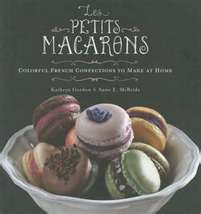“Another macaron book?” you ask. There was that list of best macaron books a couple of weeks ago and then the Pierre Hermé book and now …
Trust me. I need to undo an oversight and make your macaron life wonderfully secure. This book is a necessity.
Suzen and I know many cookbook authors and there is one dominant characteristic for the great ones: pride. Not ego. Pride. A really good author has the confidence from knowing their subject manner, from testing their recipes, from targeting their writing towards an audience that mostly did not go to the CIA. The good author has made sure that the production quality of their book makes it enticing.
And a really good author will make sure that you know they have created a great book. So, after I published the list of top macaron books, co-author Kathryn Gordon of Les Petits Macarons sent me a copy of her book — authored with Anne McBride — and included a very thoughtfully penned note. She said that I had “missed” her book. That is so gracious of her. I should never have written that review without including this book.
I now am a tad shy about saying a particular macaron book is “the best.” Let’s just say that if you only own one or two macaron books, then Les Petits Macarons must be one of them.
Why? This book explains in very understandable detail the mystery of macarons. The cookie itself has just four primary ingredients: almond flour, confectioner’s sugar, granulated sugar, and egg white. But combining those four to produce a great macaron that holds up for a few days, well, that’s a bit of a challenge. If you doubt me, take a tour of the many macron stores in New York City. The spectrum of quality, from awesome to bulimic-inducing, is mysterious.
This book will get you to the awesome level in the first try. There are two primary reasons this book is outstanding:
- Impeccable details on four different techniques to create the macaron batter
- Incredible variety in the recipes for flavoring the cookies/shells themselves and then the fillings
Macrons are “meringue” based but that means there are important options. French macrons use a meringue of beaten egg whites and sugar. The other books I in my earlier review do, sometimes, mention the Italian technique: make a boiling sugar syrup and beating that into the egg white. Les Petits Macarons gives you two further options. In a Swiss meringue technique, the egg whites are cooked along with sugar. And there is an “easiest” method where the egg whites are simply stirred into the dry ingredients — amazingly no egg white whipping at all.
Les Petits Macarons explains why these different techniques work, how they generate meringues with different physical qualities, and what adjustments you will then need to make. Which technique is best? The authors point out that “best” is in the eye of the beholder and that many chefs have “one” way of making macarons because that is what they learned early in their career.
The recipe variety comes from separating the cookie or shell part from the filling part. Chapters deal with:
- Sweet Cookie Shells: made with nuts, cocoa, espresso, lemon, spices or berries
- Savory Shells: featuring parsley, saffron, peppercorn, ancho chile, sesame and, yes, wasabi
- Ganache Fillings: featuring both chocolate and spice combinations [chocolate-grapefruit or lemon-star anise!]
- Creamy Fillings: buttercreams galore ranging from standard vanilla to pear cream
- Caramel Fillings: including fleur de sel and blood orange and many more
- Frozen Fillings: distinctive ideas including anise ice milk and persimmon ice milk
- Fruit Based Fillings: like cinnamon-apple butter with calvados and strawberry-guava pate de fruit
- Classic Fillings: German chocolate cake, red velvet, dulce de leche, …
- Savory Fillings: include chevre-rosemary, maple-bacon-bourbon, and duck confit with port and fig
I bet you’ve never seen many of these ideas. Personally, I’m up for wasabi cookies with that duck confit! Imagine a New Year’s Eve party featuring sparkling wine and macarons with savory shells and savory fillings!
There are so many combinations here, that you can do a macaron a day for a year. Ah, but when you do, Les Petits Macarons will tell you why you need to age your egg white and how to do it.
Oh, is it macaron or macaroon? It’s macaron and the history is all told you to you here.
All you need is this book and a lot of almond flavor and a few dozen eggs. You are then totally prepared for flavor journeys you could never have imagined.


Hello!
Thanks for your great advice! So by reading your reviews, I still find it hard to know which book should I get for someone who, although talented for cooking/baking, etc., is totally new to the world of Macarons. Which book/books would you then recommend for someone like this?
Thanks!
If you are looking for a beautiful and professional macarons book, then I strongly suggest Pierre Herme’s Macarons. It’s very detailed, but macarons — great macarons — are labor of love. Be sure to have a very accurage thermometer for all the steps.